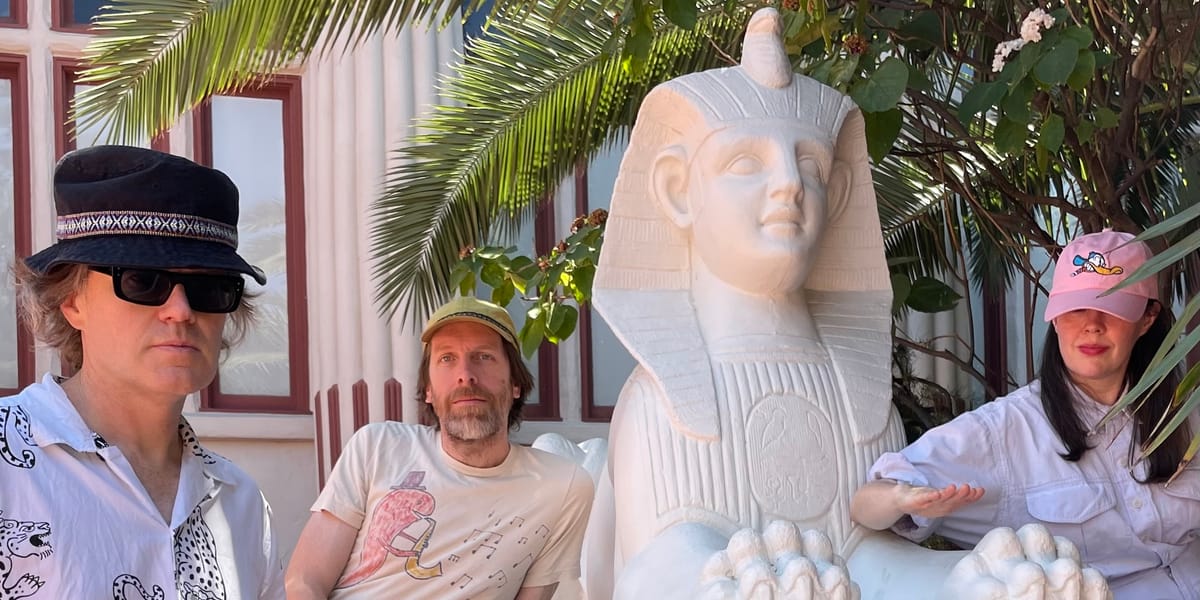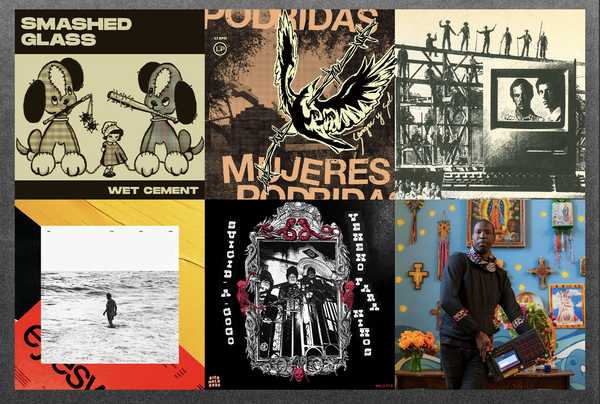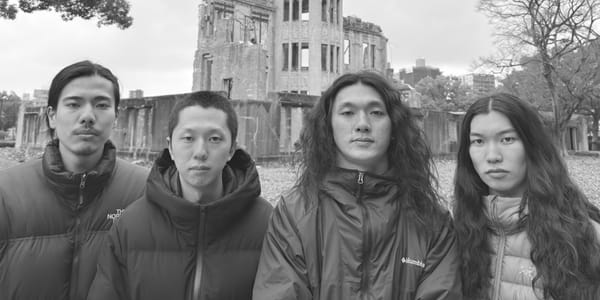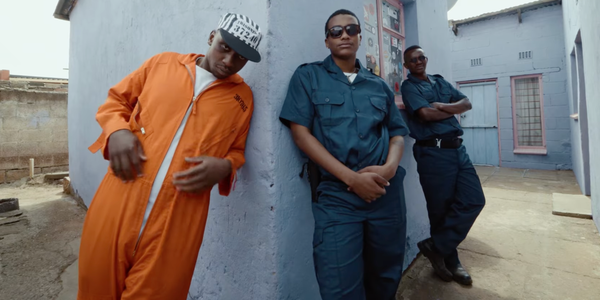magik markers built an album around a junkyard effects pedal
Elisa Ambrogio and Pete Nolan on the moodboard of their improvisational new album A New Kind of World: “Wow, Joni [Mitchell] never made her Trans.”

The three musketeers of Magik Markers are far apart these days: drummer Pete Nolan and bassist John Shaw live a few hours apart in Massachussetts and Vermont, while guitarist and vocalist Elisa Ambrogio resides in northern California with Ben Chasny, who’s known elsewhere for his artistry as Six Organs of Admittance. Despite their geographical differences, the long-running trio pulled together a surprise, synth-heavy release, A New Kind of World, which arrived on Bandcamp on July 5, ahead of a rare stretch of tour dates in California.
Nolan started booking the summer outing back in December, aiming to take advantage of the seasonal break he gets from teaching special needs second graders. A record came together much faster as the tour approached, with Nolan and Shaw carving out time to jam together at Nolan’s home studio. Ambrogio completed the tracks and their mixes with some final touches from Chasny a few hours before uploading them to Bandcamp. “Elisa really did a killer job of pulling different sounds out of it, because I think what John and I had done was a lot more loud, or it wasn't as refined,” Nolan says. “I wasn’t sure that it sounded like Magik Markers, and then as soon as Elisa was finished with it, I was like, ‘Oh man, this sounds like Magik Markers!’”
A New Kind of World’s title track opens the record with a 26-minute sprawl, stretching outward from a slow churn into open electronic waves and spiky guitar. The rest of the record continues through a parade through images of weird America, with name-checks and nods to Arlo Guthrie, skunk weed, Coney Island, distant stars. Within “Boomer Sadness,” Ambrogio deconstructs Joni Mitchell’s “Both Sides Now” to imagine another outcome for the elder icon. The peaty foundation of murky synths developed from Shaw’s refusal to give up on a revamped pedal in his armory, while Nolan borrowed his daughter’s Stylophone drum machine for a new rhythmic palette.
Nolan and Ambrogio exchange plenty of laughter as they talk about the fast-and-loose nature of their latest creation, with Shaw getting ribbed and revered in absentia. Companionable energy and fuck-it attitudes among the Markers seem to roil nonstop, even from afar. “There's a weird positive where [the music] ends up being more than the sum of its parts,” Ambrogio says. “Despite our best efforts, we end up doing good things when we come together.” She and Nolan logged on from opposite coasts to chat some more about keeping their creative engines running and the other forces behind A New Kind of World.
How do the three of you figure out working together while you’re far apart?
Elisa Ambrogio: Mind practice. John just got a smartphone—I don't know if you heard about these, but you can text on them.
Pete Nolan: It doesn't actually work where he lives, though. He lives in the middle of nowhere, so I'll text him, and four days later, he’ll do a “Haha.” John and I practiced a few times. Elisa had this idea to make a new recording to go along with this tour to help pay for it. John's father-in-law is a forager of dumps, and he's always finding weird, crazy shit. John had a pedal that his father in law found, and it was some kind of an Akai synthesizer called Deep Impact. He wanted to try that out, because he said he tried it at home, and just it made him cringe. But it felt good when we jammed together.
Elisa: So we went ahead and based the whole record on it.
Did you come at this project like “let’s make an album,” or were you just working on some new material to take out?
Elisa: It was sort of improvisatory, pretty quick. First thought, best thought; finding different stuff that is fun about making music, different sounds and ideas, trying stuff out that we had been thinking about doing. It's not as formal as one of our full-length records that we are a little bit more methodical with.
Pete: It was pretty loose. We’ve had the thought, “We should work remotely, figure out how to do that.” This is the first time we've really kind of pulled it off. John and I just jammed a bunch of stuff and recorded it, and I edited that down and sent the tracks to Elisa.
Elisa: I got the recordings, and the first track was 26 minutes. I was like, Sweet. I wanted my guitar really spare and sparse, not loud and not overwhelming, sort of vulnerable guitar, just like beep. It was, like, a little guy, and I because there was such a force with the synth sounds and these overwhelming bass tones and washes of sound. So for me, it was just sort of listening to my band and being like, “Oh, this band rules. I love this band,” and kind of just playing along and singing some stuff.
It all came together really quickly. I think that's sort of the way that it works best. It was Fourth of July when I recorded the end of the vocals. Local people were lighting off fireworks, so as I was recording, talking, singing and moving tracks around—when you write this, you can put in parentheses, “Elisa makes mouth sounds of fireworks and synths.”
You were doing the vocals on the 4th of July, and then released the record the next day? I’m curious, too, about the logic behind doing it as a surprise release.
Pete: We really are just trying to pay for the tour. And guess what, we are two-thirds of the way there! We decided to make it into a CD too, so there will be a physical version of it that we can sell on the tour as well. Putting something up on Bandcamp the next day, that does feel pretty fucking punk, but not that big a deal. It’s not that hard to do.
Elisa: It’s not that different than anything we’ve ever done. We would be like, “Oh, we have to go on tour, take the show from last night and put it on a CD-R.”
And Elisa, how did you go about writing lyrics for a 26-minute song?
Elisa: Very carefully. With almost every single song I work on, I feel like I come up with an idea—not a thesis statement, but just an idea. I write a lot, every day, I have notebooks and notebooks and Apple notes. I will listen on headphones, over and over, to tracks and sounds, and if I have a vibe, it will come from the music. I kind of look through words, and through chance operations, something will just go like, Beep! Hello! Click! Sometimes it's nothing I've written down, just stream-of-consciousness, or whatever—not trying to be precious, just listening to what other people are doing and responding in real time.
As you worked on your pieces of the record, were there any particular moods or themes that either of you were chasing?
Pete: When John and I got together, I had just recently seen this Instagram post of the artist Paul McCarthy. He does the stuff with Mike Kelley, and it's all pretty gross, weird performance art, super strange shit. He posted a super long jam that he had done. It looked like this ultimate noise show, but it was so sick. I was just like, “Oh, man, I love this. I'm gonna watch the whole thing and show that to John.” We watched this, and then we're in that headspace, and we were just like, “We have all this new gear, we're just going to fuck around with it and try to just find sounds.”
Elisa: I had watched this really, really beautiful documentary about this woman, Berenice Abbott. She was 92 or something, and she just kept learning and growing, trying new things and taking risks. In any phase of your life, you can either calcify and shut down. I remember I was 26 and my friend was like, “We’re not kids anymore. We have to grow up,” as though art, music, or writing was some childish thing to put away.
It was so inspiring to watch this woman go from being in the same scene as Gertrude Stein in postwar Paris to taking some of the most beautifully rendered scientific photography. As soon as I heard the synth, I was like, “Science!” I immediately thought of Berenice Abbott and that joyful freedom feeling, where you could just feel that Pete and Shaw were in their element and their joy in what they were doing. It just translated.
Within that was just like something that, to me, was free and open—like outer space, and that kind of weird optimism of space. I don't know why that reminded me of Coney Island, it felt fun and automatic. That's sort of a weird Coney Island, America feeling, too—that automation and man-made ambition and weird openness. I thought about Coney Island, Arlo Guthrie, and people like that. When I was little, my dad and my papa always brought me to Hampton Beach in New Hampshire. A singular and defining story of my childhood that I was told over and over was “Arlo Guthrie held you on his lap in the swimming pool.”
I was going to ask if that was real!
Elisa: It was not only real, it was repeated like a mythology in my childhood, over and over. I didn't know one single Arlo Guthrie song. I didn't know that his dad was Woody Guthrie. I didn't know anything about him. I was like, “He must be a very important man.”
“Boomer Sadness” tugged at my own heartstrings—I really like what you did pulling apart “Both Sides Now.” What’s the story or thought behind what the band did with this one?
Elisa: I don't know if there was a note or if there was something in what Pete said, but I just instantly started singing Joni Mitchell to it. I was like, “Wow, Joni never made her Trans.” I thought, “I'll just do it for fun.” Thank you for even knowing what it was. I was like, “I don't think anyone's gonna even know what this is.” As much as many people love Joni Mitchell, she's so under appreciated as a songwriter, as a musician, as a technician. She's a labyrinth inside of a maze locked inside a box.
You guys are coming up on 25 years together as Magik Markers, what do you still like about working with one another?
Elisa: We didn’t say we liked it. [both laugh]
Pete: It’s so much fun. We all crack each other up a lot. If I was going to give my daughter advice about being a band, the main advice would be, “Get into a band with people that you would enjoy sitting in a car with for eight hours, and it will not get boring.”
Elisa: I was just thinking, “Oh man, I'm so stoked to find out what Shaw and Pete have been listening to and watching and thinking about.” It’s never what I am listening to or thinking about or watching, but it's always something I want to be thinking about or listening to or watching.
Pete: It's also long-haul conversations. I called John to ask him one yes-or-no type question today. But before I could get to that, we had to talk about blueberries for 12-15 minutes, because that's what John was up to right now.
see/saw is a reader-supported publication. If you enjoyed this article, please consider a paid subscription to support this independent punk journalism operation.




